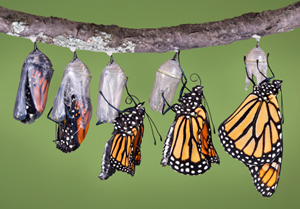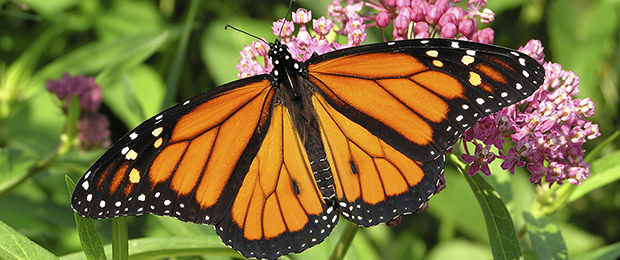Monarch Butterfly
My life begins enclosed in an egg. Sheltered by a shell, preparing to face the world. My mother places me on a milkweed plant. This is where I will get my nutrients needed to transform into the next phase. The egg that surrounds me is approximately the size of a “pinhead” and is a yellowish color. After four days, my egg shell is ready to hatch. After my egg has hatched, I am ready to transform into larvae. Being larvae is also known as a caterpillar. During this stage, my body becomes three distinct sections, the head, thorax, and abdomen. During this stage, I view the world silvering along the ground. The forest is my playground and the sun is gazing down on me. After a caterpillar it is time to change into a pupa or a chrysalis. During this stage, the wings and vital organs continue to develop. By the end of this process, the transformation is complete. It is finally time to transform into a butterfly. Becoming a butterfly has been a beautiful journey and the great part is, the journey is just getting started. I am not just a regular butterfly, but a monarch butterfly. I am known as the “Queen of the butterfly” and I am extremely unique. Now that I am an adult, it is finally time to do the one thing every butterfly looks forward to, migration.

Every year there is a mass migration of us monarchs that travel to Mexico and California
for the winter. This migration happens every year and due to the fact that I was born during the summer I am ecstatic to be a part of the journey this year. Travelling across the country gives me great anxiety, but I am hopeful. The opportunity to explore the world and discover new opportunities is a memory that will always linger. The only problem causing me stress, is the fear of getting lost from the pack. I was born to fly, to soar through the clear blue sky on a beautiful and sunny day. Letting my orange and black wings glide through the crisp air. As exciting as this is, travelling three thousand miles is a strenuous task. I hope I have enough stamina for the trip and we take plenty of rest breaks. I always pondered upon the question of, how do we know when it’s time to migrate? I learned it is time to migrate when the temperature changes. I can sense this, because of my high sensitivity to the weather and climate. Apart from the weather alerting me when to migrate, I also depend on various environmental cues to alert me when it is time to reproduce, migrate and even hibernate. This is challenging for us, due to climate change. Because of warmer than normal temperatures our migration is approximately six weeks late. Our trigger to leave Canada is set off solely based on temperature. When the temperature is too warm we extend our stay longer than necessary. Due to us leaving late, by the time we arrive to the Midwest, it is too cold. A lot of my family ends up dying due to the unbearable weather and their inability to adapt. 
VIDEO: This video shows the monarch butterflies migrating to Mexico. https://youtu.be/Z9rZz3fILt4 Not only does climate change affect our journey
every year, it also affects our food supply. With the temperatures increasing, our milkweed supplies are starting to decrease. Milkweed is our main source of food, especially during the caterpillar stage. Aside from milkweed our diet also consists of anything liquid based. This includes anything from tree sap, pollen, rotting fruit, and the sodium in salt or water. With this drought, there are limited destinations where we can eat and have the proper nutrition to reproduce. This is a huge problem considering we migrate from Canada to the South every year. With fewer options our journey becomes burdensome. This is a devastating reality that we must face sooner or later. We thrive off of reproduction and our ability to expand our families. With temperatures rising, this task that was once simple is now becoming strenuous. Our monarch population is decreasing yearly and pretty soon our species could be on the verge of extinction. Climate change is a very dangerous problem and is putting fellow members and myself in harm’s way. Warmer weather and longer summers may not seem like a huge deal to humans, but to us monarchs, it matters. What will it take for humans to realize that our earth is in serious danger? That climate change is a real problem that affects millions of animals every year? Hopefully they wake up soon and help save us monarchs!
As humans, it is our duty to help fix a problem that we a hand in creating. Monarch butterflies are at risk of extinction, due to climate change. By definition, climate change is “a change in global or regional climate patterns, in particular a change apparent from the mid to late 20th century onwards and attributed largely to the increased levels of atmospheric carbon dioxide produced by the use of fossil fuels.” In other words, climate change is caused by our increase in the use of fossil fuels like, natural gas, oil, peat and coal. When we use these
fuels for our own personal use we do not consider the lasting effects they have on animals like
the monarch butterfly. According to NASA, “a group of 1,300 independent scientific experts from countries all over the world under the auspices of the United Nations, concluded there's a more than 90 percent probability that human activities over the past 50 years have warmed our planet.” Knowing that we have a direct cause in climate change speaks volumes about how we treat the planet. Our natural resources might seem to be everlasting now, but eventually things do come to an end. When these natural resources run out, will we be able to say that we used our resources wisely and made a genuine effort to keep our earth clean? Or will we no longer have any natural resources and the earth as we know it no longer exists? The choice is up to us.
Apart from us having our input in the cases of climate change, there are other reasons as well. Within the last six hundred thousand years there were seven different cycles of various glacial advances and retreats. Likewise, seven thousand years ago marked the end of the ice age and the beginning of a new era. Climate changes have happened due to “variations in Earth’s orbit that change the amount of solar energy our planet receives.” A main factor causing global warming is known as the “greenhouse effect.” This is caused when the atmosphere traps heat that is radiating from the earth. Likewise, other gases also deny the heat from escaping. Similarly, it was discovered that Venus was roasted by the greenhouse effect. This phenomenon got its name, because a greenhouse is a building that allows sun to enter and locks the heat inside. Whether it’s hot or cold outside, the building will always be warm. Like greenhouses, the earth lets in light and traps the heat. For this reason, it is known as the “greenhouse” effect.
However, there are ways that we can reduce climate change. One way to do this, is to reduce your energy use. Turning the lights off when you leave the house or opting to use natural
sunlight instead of the lights. When washing laundry, you can wash your clothes on cold. Instead of putting your clothes in the dryer, you can hang them up to dry. This reduces your energy use and can make a huge difference. When travelling somewhere with friends, try carpooling rather than taking separate cars. At the same time, it might be beneficial to get some sunlight and walk. It is also very important to update your appliances to high efficiency appliances. Doing this allows you to use less energy, since the products are newer and more efficient. One of the easiest things to do, is to conserve your water usage. Taking shorter showers or baths can definitely
reduce your energy use or using the dishwasher rather than hand washing your dishes. Finally, one of the easiest things to do in order to reduce your energy use is to recycle. Growing up in school, we were taught the importance of recycling and doing something small can make a huge difference. Doing these steps or even just some of them reduce your energy use which in turn reduces climate change. With everyone participating, we can save the beautiful monarch butterflies one shower at a time!
Word Count with quotes : 1455
Word Count without quotes : 1401
1 NASA. Accessed November 21, 2016. http://climate.nasa.gov/evidence/.
2 "Canada's Action on Climate Change." Government of Canada, Environment and Climate Change Canada. 2016. Accessed November 21, 2016. http://www.climatechange.gc.ca/.
Media Citations
1 "Monarchs." Pinterest. Accessed November 21, 2016.